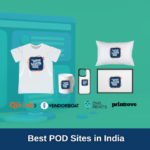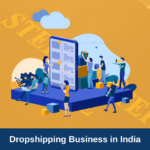In today’s fast-paced world, businesses not expanding globally are often left behind. One such business that has seen a tremendous increase in recent years is print-on-demand.
Print-on-demand is a business model where products are created only after a customer has ordered them. This eliminates the need for large inventory quantities and allows businesses to offer a wide range of print on demand products without the risk of unsold stock.
If you’re running a print-on-demand business, it’s time to think beyond your local market and explore the vast opportunities in the global market. In this article, we’ll discuss some effective strategies to help you expand your print-on-demand worldwide.
How to expand your print on demand business worldwide?
1. Conduct market research

Before expanding your print-on-demand business globally, conducting thorough market research is important. This will help you identify potential customers, understand their needs, and evaluate the competition. You can conduct market research by analyzing online trends, studying customer behavior and purchasing patterns, and exploring social media channels.
Here are some tips that can help you get started:
Define your research goals and objectives:
Before you start conducting market research, it’s important to define what you want to achieve and what questions you want to answer. This will help you stay focused and ensure that you’re collecting the right data.
Choose your research method:
There are many ways to conduct market research, including surveys, focus groups, interviews, and observation. Choose the method that best suits your research goals and budget.
Identify your target audience:
Knowing your target audience will help you tailor your research questions and methods to get the most accurate and useful data.
Collect and analyze data:
Once you’ve collected your data, it’s important to analyze it carefully to identify patterns and trends. This will help you draw meaningful conclusions and make informed decisions.
Use your research findings:
Finally, use your research findings to inform your business strategy, marketing campaigns, and product development efforts. You can make more informed decisions and achieve greater success by leveraging your research data.
2. Choose your target markets wisely
Once you have conducted market research, the next step is to choose your target markets. You need to identify the countries and regions with high product demand and where you can gain a competitive advantage. Some factors to consider when choosing your target markets are:
– Cultural fit: Understand the cultural nuances of your target markets and tailor your products and marketing accordingly.
– Legal and regulatory requirements: Be aware of each target market’s legal and regulatory requirements to avoid legal issues.
– Shipping costs and logistics: When choosing your target markets, factor in shipping costs and logistics.

3. Localize your products and marketing
Localization is one of the most important aspects of expanding your print-on-demand business globally. Localization involves adapting your products and marketing to suit the local preferences of your target markets. This includes:
– Translating your website and product descriptions into the local language.
– Adapting your products to suit local tastes and preferences.
– Customizing your marketing campaigns to appeal to local customers.

4. Use E-commerce platforms
E-commerce platforms like Amazon, eBay, and Alibaba can help you reach a wider audience and expand your business globally. These platforms provide a ready-made customer base and handle the logistics and payment processing. However, you need to be aware of the fees and commissions charged by these platforms and factor them into your pricing strategies.

5. Offer competitive pricing
Offering competitive pricing is crucial when expanding your print-on-demand business globally. When setting your prices, you must factor in shipping costs, taxes, and other expenses. It’s also important to monitor the competition and adjust your prices accordingly. Offering discounts and promotions can also help you attract new customers and retain existing ones.

6. Provide excellent customer service
Providing excellent customer service is essential to the success of your print-on-demand business. This includes:
– Responding promptly to customer inquiries and complaints.
– Offering easy and hassle-free returns and refunds.
– Providing tracking information and order updates.
– Going the extra mile to exceed customer expectations.


How to design a website to sell print on demand worldwide - Key considerations
Designing a website that can sell products print-on-demand worldwide requires careful consideration of several factors. To be successful, you must cater to the needs of a global audience and ensure that your website is user-friendly, accessible, and culturally sensitive.
Here are some key considerations to keep in mind:
1. Language and localization
Language and localisation are among the most important considerations when designing a website for a global audience. You need to ensure that your website is available in multiple languages to cater to users from around the world. You can use translation tools or hire professional translators to accurately translate your website content.
Localization involves adapting your website to suit the cultural preferences of your target audience. This includes using appropriate currencies, date formats, and measurements and understanding cultural nuances and customs. Consider hiring a localization specialist to ensure your website is culturally sensitive and appropriate for your target audience.
Action step: Conduct market research to identify your target audience and their language and cultural preferences. Use translation tools or hire professional translators to provide accurate translations of your website content.
2. Payment and shipping
Payment and shipping options are another important consideration when designing a global website for a global audience. You need to ensure that your website supports multiple payment options and currencies to make it easy for users to purchase from anywhere in the world. You can use payment gateways like PayPal or Stripe to offer secure and reliable payment options.
Shipping options are also critical when selling products worldwide. You need to consider the shipping costs and logistics involved in delivering products to different parts of the world.
Action step: Research and identify reliable payment gateways and shipping providers that support global transactions. Offer multiple payment options and use shipping providers that offer reliable and affordable shipping options.
3. Mobile responsiveness
With more people accessing the internet through mobile devices, designing a mobile-responsive website is essential. Your website should be optimized for mobile devices and offer a seamless user experience across different devices and screen sizes. This will ensure that users can access your website and make purchases from anywhere in the world, regardless of their device.
Action step: Use a responsive design that adapts to different screen sizes and devices. Test your website on different devices and screen sizes to ensure that it offers a seamless user experience.
4. User experience
To sell products worldwide, you need to offer a great user experience that caters to the needs of your global audience. Your website should be easy to navigate, offer clear and concise product information, and provide a seamless checkout process. You can use user testing and analytics tools to understand how users interact with your website and make improvements based on their feedback.
Action step: Conduct user testing and analytics to understand how users interact with your website. Use the insights to improve the user experience and increase conversions.
5. Legal and regulatory compliance
When selling products worldwide, you must comply with legal and regulatory requirements in different countries. This includes data protection laws, consumer protection laws, and tax regulations. Ensure your website complies with the legal and regulatory requirements in each country where you sell products.
Action step: Research and understand the legal and regulatory requirements in each country where you sell products. Consult legal experts to ensure your website complies with the relevant laws and regulations.
How does Qikink help to sell print on demand products worldwide?
Qikink is a print-on-demand service that offers international shipping services to help businesses sell their products globally. With Qikink, businesses can easily create and sell custom products, such as t-shirts, phone cases, and mugs, without worrying about inventory or shipping logistics.
Qikink’s international shipping services allow businesses to expand their reach and sell products to customers worldwide. Qikink helps businesses increase sales and grow their customer base by offering low shipping rates and fast delivery times.
To start with Qikink, businesses can simply create an account on their website and upload their designs. From there, Qikink takes care of the rest, including printing, packaging, and shipping the products to customers worldwide.
To contact Qikink, businesses can visit their website and submit a contact form. They also have a helpful customer support team available to answer any questions and provide assistance with their services.
Qikink’s print-on-demand international shipping services offer a convenient and cost-effective way for businesses to sell their products globally and reach new customers worldwide.
Conclusion
Expanding your print-on-demand business worldwide requires careful planning, market research, and localization. By choosing the right target markets, partnering with the right suppliers, and offering competitive pricing and excellent customer service, you can tap into the vast opportunities in the global market. With the right strategies and mindset, you can take your print-on-demand business to new heights and achieve global success.
Read more
- How to Start a Print on Demand ECommerce (Step By Step Guide – 2023)
- How To Optimize a Print On Demand eCommerce Website For Conversions? (Step-by-Step Guide to Double Your Conversion Rate)
- 10 Smart Pricing Strategies for Print-on-Demand Products
- 25 Best Print on demand websites in India for 2023
- The Rise of T-Shirt Print on Demand in India: A Booming E-Commerce Trend
Frequently Asked Questions
What steps should I take to expand my print-on-demand business to a global audience?
To expand your print-on-demand business to a global audience, you should
- conduct market research,
- choose your target markets wisely,
- localize your products and marketing,
- use e-commerce platforms,
- offer competitive pricing, and
- provide excellent customer service.
How can I adapt my products to cater to different international markets?
To adapt your products to cater to different international markets, you should consider cultural preferences, local tastes, legal and regulatory requirements, and shipping costs and logistics. Localization is key to ensuring that your products are well-received in different markets.
What are the key considerations for international shipping in a print-on-demand venture?
Key considerations for international shipping in a print-on-demand venture include shipping costs, customs and duties, delivery times, and tracking information. It’s important to work with reliable and experienced print-on-demand service providers to ensure that your products reach your customers safely and on time.
Are there language and cultural aspects I should address when going global with my business?
Language and cultural aspects are important considerations when going global with your business. You should offer your website and product information in multiple languages and adapt your marketing and products to suit the cultural preferences of your target audience.
What marketing strategies are effective for reaching a diverse global customer base?
Effective marketing strategies for reaching a diverse global customer base include social media marketing, influencer marketing, content marketing, and search engine optimization (SEO). It’s important to understand the unique needs and preferences of your target audience in different markets and tailor your marketing efforts accordingly.
With over 6+ years of experience in the industry, Ayushi excels in building strong customer relationships and guiding clients toward growth as a Brand Partnership Manager. She enjoys sharing her experience in her content.



































































